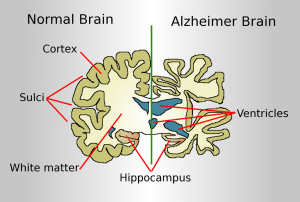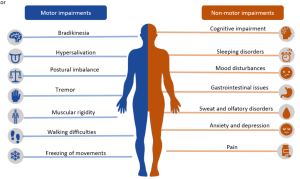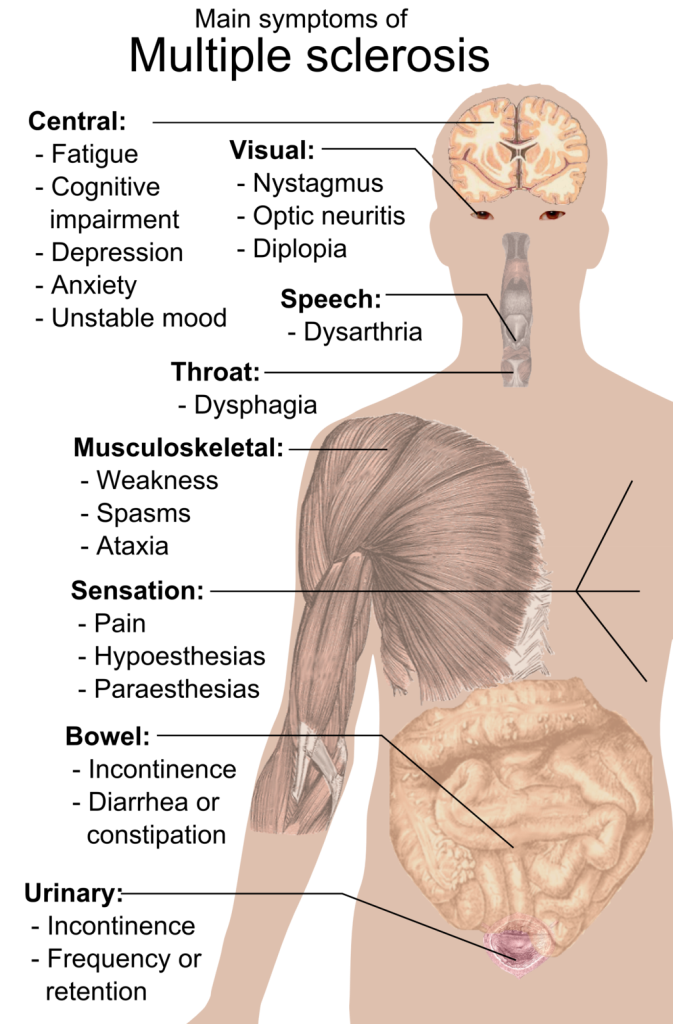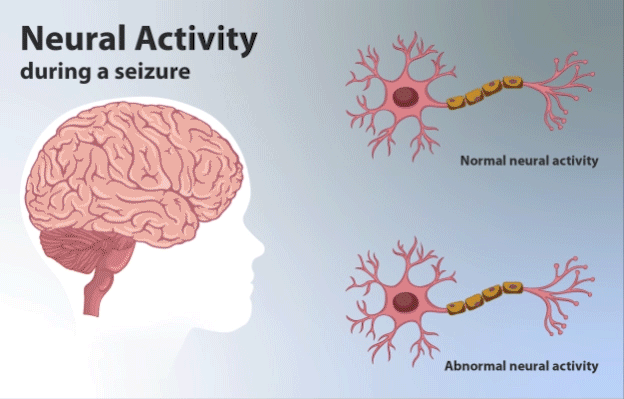9.3 Nervous System Pathologies
This section examines some of the more common pathologies associated with the nervous system. Some of the rarer pathologies are also discussed because of their severity.
Alzheimer’s disease: This is a form of dementia that is characterized by the accumulation of beta-amyloid plaque, a type of dense protein found in the cerebral cortex. It is a degenerative disease in which individuals experience memory loss and confusion. The brain atrophies (shrinks) as the condition progresses. Alzheimer’s disease accounts for 60% to 80% of all dementia diagnoses, which makes it the most common type of dementia (Alzheimer Society, 2022). It is a fatal disease that affects all aspects of someone’s life. Although it is a progressive degenerative disease, it affects everyone differently and progresses at varying rates among individuals (Alzheimer Society, 2022). Fig. 9.6 shows the differences between the brain of someone who has Alzheimer’s disease compared to someone who does not. The sooner this disease is diagnosed and treated, the better the quality of life the patient will have as they progress through this condition (Alzheimer Society, 2022).

Amyotrophic lateral sclerosis (ALS): A rare neurological disease, ALS mostly affects the nerve cells (neurons) responsible for controlling the voluntary muscles (NINDS, 2022). Voluntary muscles are the ones we choose to move. This disease is progressive, which means it will continue to worsen, and there is no cure (NINDS, 2022). The signs and symptoms of ALS begin with muscle weakness or stiffness, then progress to affect all the voluntary muscles. Eventually, patients lose their strength and the ability to speak, eat, move, and even breathe. Respiratory failure is usually the eventual cause of death, which typically occurs within three to five years after the onset of symptoms (NINDS, 2022).
Huntington’s disease: This rare and inherited disease causes the progressive breakdown of nerve cells in the brain (Mayo Clinic, 2022). Symptoms generally appear in middle life and affect movement, cognition, and mental health (Mayo Clinic, 2022). They include involuntary movements, muscle rigidity, impaired gait and balance, and difficulty with speech. The disease also causes cognitive deficits such as difficulty focusing, behaviour changes, lack of impulse control, and lack of awareness of one’s own behaviours (Mayo Clinic, 2022). Depression and mania are also common symptoms for those with Huntington’s disease. Medications can be used to manage many of the symptoms, but they will not prevent the progression of this condition (Mayo Clinic, 2022).
Parkinson’s disease: A progressive disease of the nervous system, Parkinson’s impairs a person’s ability to move. The typical onset for symptoms is in the middle to later stages of life; there is no cure, and once symptoms develop, they will continue to worsen. The exact cause of this disease is unknown, but it is widely accepted that an imbalance of dopamine and acetylcholine play a role. Fig. 9.7 provides a list of the common motor- and non-motor-related symptoms that those with Parkinson’s disease experience.

Meningitis: This is an inflammation of the meninges—the three layers of fibrous membrane that surround the central nervous system (Betts et al., 2013). Meningitis can be caused by infection by bacteria or viruses, and the particular pathogen that causes meningitis is not necessarily specific to the disease, so the bacteria or virus can also cause other infections in the body (Betts et al., 2013).
The symptoms associated with meningitis include fever, chills, nausea, vomiting, light sensitivity, neck soreness, and severe headache (Betts et al., 2013). There are also neurological symptoms such as changes in mental state, including confusion, memory deficits, and other dementia-like symptoms (Betts et al., 2013).
Bacterial meningitis is fatal in about 5% to 40% of children and 20% to 50% of adults (Betts et al., 2013); antibiotics are used to treat bacterial meningitis. Viral meningitis cannot be treated with antibiotics (Betts et al., 2013), but often, the symptoms are not as severe as for bacterial meningitis.
Multiple sclerosis (MS): This autoimmune disease is characterized by an abnormal response of the body’s immune system directed against the central nervous system (CNS). The immune system causes inflammation within the CNS that damages myelin, as well as the nerve fibres themselves and the specialized cells that make myelin. When myelin or nerve fibres are damaged or destroyed, messages travelling through the CNS are altered or stopped completely. Damage to areas of the CNS produce a variety of neurological symptoms that will vary among people with MS. The damaged areas develop scar tissue that gives the disease its name—multiple areas of scarring, or multiple sclerosis. The cause of MS is not known, but it is believed to involve genetic susceptibility, abnormalities in the immune system, and environmental factors that combine to make MS symptoms variable and unpredictable. No two people have exactly the same symptoms, and each person’s symptoms can change or fluctuate over time. One person might experience only one or two of the possible symptoms, whereas another person might experience several symptoms of the disease. Fig. 9.8 provides a summary of the common symptoms that those with multiple sclerosis may experience.

At this time, there are no symptoms, physical findings, or laboratory tests that can, by themselves, be used to diagnose whether a person has MS. Several strategies are used to determine whether a person meets the criteria for a diagnosis of MS and to rule out other possible causes of whatever symptoms they are experiencing. These strategies include a detailed medical history, a neurological exam, and various tests, including magnetic resonance imaging (MRI), spinal fluid analysis, and blood tests.
Seizures: This condition is defined as the transient occurrence of signs and symptoms caused by abnormally excessive or synchronous neuronal activity in the brain. This means that during a seizure, large numbers of brain cells are activated abnormally at the same time. It is similar to an electrical storm in the brain and is shown in Fig. 9.9. Seizures may alter consciousness and produce abnormal motor activity. There are different classifications of seizures based on the severity of symptoms. Seizures can be diagnosed and identified based on a test called an electroencephalogram (EEG).

Classification of Seizures
Seizures are classified in many ways, beginning with whether they are focal or generalized.
- Focal seizures: Onset is on one side of the brain, and these seizures are classified as simple, complex, or secondarily generalized.
- Simple partial seizures are the most common and may affect both sensory and autonomic systems. These seizures may cause twitching or changes in sensation (CDC, 2022).
- Complex partial seizures cause impairment of consciousness, with or without motor activity or other signs. The individual may appear dazed or confused (CDC, 2022).
- Simple or complex partial seizures may become secondarily generalized, producing a tonic-clonic seizure (CDC, 2022).
- Generalized seizures: Onset is bilateral, on both sides of the brain, and these seizures are classified as absence or tonic-clonic.
- Absence seizures, sometimes called petit mal seizures, can cause rapid blinking or a few seconds of staring into space.
- Tonic-clonic seizures, also called grand mal seizures, can make a person exhibit the following symptoms(CDC, 2022):
- Loss of consciousness
- Muscle jerking (clonic)
- Muscles becoming limp or weak (atonic)
- Tense or rigid muscles (tonic)
- Status epilepticus is a state of repeated or continuous seizures and is often defined as a single seizure lasting more than 20 minutes or repeated seizures without recovery of consciousness. Prolonged status epilepticus can lead to irreversible brain injury and has a very high rate of mortality. The goal of therapy should be to achieve control of a seizure within 60 minutes or less.
Attribution
Unless otherwise indicated, material on this page has been adapted from the following resource:
Ernstmeyer, K., & Christman, E. (Eds.). (2020). Nursing pharmacology. Chippewa Valley Technical College. https://wtcs.pressbooks.pub/pharmacology/ licensed under CC BY 4.0
References
Alzheimer Society. (2022). What is Alzheimer’s disease? https://alzheimer.ca/en/about-dementia/what-alzheimers-disease
Betts, J. G., Young, K. A., Wise, J. A., Johnson, E., Poe, B., Kruse, D. H., Korol, O., Johnson, J. E., Womble, M., & DeSaix, P. (2013). Anatomy and physiology. OpenStax. https://openstax.org/details/books/anatomy-and-physiology licensed under CC BY 4.0
Centers for Disease Control and Prevention (CDC). (2022). Types of seizures. https://www.cdc.gov/epilepsy/about/types-of-seizures.htm
Mayo Clinic. (2022). Huntington’s disease. https://www.mayoclinic.org/diseases-conditions/huntingtons-disease/symptoms-causes/syc-20356117#:~:text=Huntington’s%20disease%20is%20a%20rare,(cognitive)%20and%20psychiatric%20disorders
National Institute for Neurological Disorders and Stroke (NINDS). (2022). Amyotrophic lateral sclerosis (ALS) fact sheet. https://www.ninds.nih.gov/amyotrophic-lateral-sclerosis-als-fact-sheet#:~:text=get%20more%20information%3F-,What%20is%20amyotrophic%20lateral%20sclerosis%3F,chewing%2C%20walking%2C%20and%20talking
Image Credits (images are listed in order of appearance)
Brain-ALZH by Garrondo, Public domain
Parkinson_disease_symtpoms by CarrotsMitHummus, CC BY-SA 4.0
Symptoms_of_multiple_sclerosis by Mikael Häggström, Public domain
Depiction_of_neural_activity_during_a_seizure by myUpchar, CC BY-SA 4.0
the fatty substance that surrounds and insulates the nerve fibres
a record of the electricity in the brain; abbreviated as EEG
a seizure characterized by a jerking (clonic) phase followed by the muscles becoming tense or rigid (tonic)

